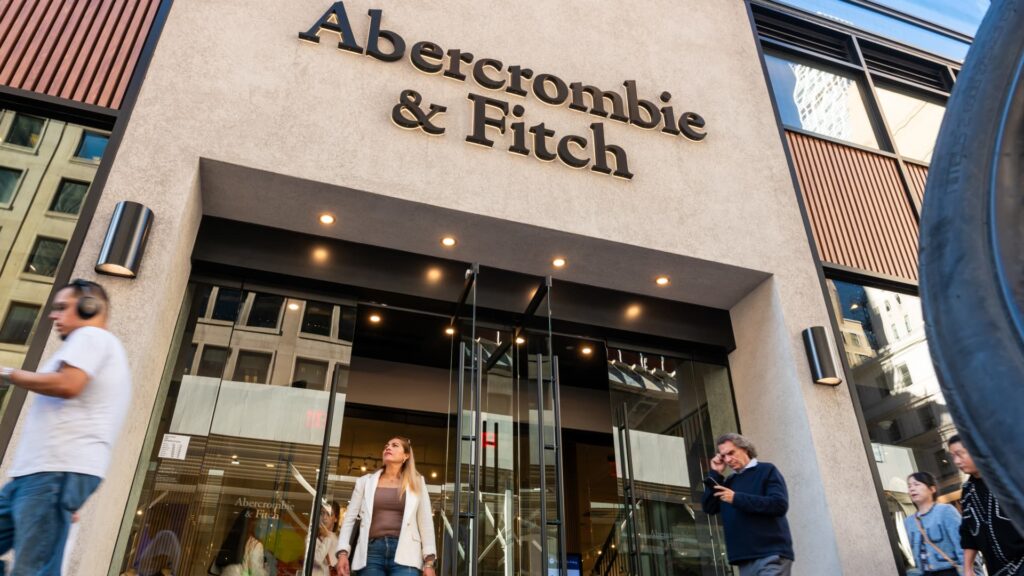Abercrombie & Fitch has reported significant growth in its latest fiscal quarter, as the brand navigates challenges with its namesake line. While sales at Abercrombie declined slightly, its sister brand, Hollister, posted a remarkable increase. The company’s stock surged in response, indicating investor confidence in its ability to adapt and thrive during the holiday shopping season.
| Article Subheadings |
|---|
| 1) Overview of Financial Performance |
| 2) Abercrombie’s Decline & Hollister’s Rise |
| 3) Strategic Changes for Growth |
| 4) Future Projections & Market Expectations |
| 5) Key Takeaways for Investors |
Overview of Financial Performance
Abercrombie & Fitch reported earnings that exceeded market expectations for its fiscal third quarter ending on November 1. The apparel retailer’s earnings per share reached $2.36, which was higher than the anticipated $2.16. Additionally, total revenue climbed to $1.29 billion, slightly surpassing the expected $1.28 billion. This performance has buoyed investor sentiment and led to a 37% increase in the company’s stock price on the following trading day.
In terms of net income, Abercrombie recorded $113 million, reflecting a decrease from $132 million in the same period last year. Despite this decline, the company managed to achieve a 7% growth compared to the previous year, primarily driven by its strategic pivot towards more successful product lines.
Abercrombie’s Decline & Hollister’s Rise
While the Abercrombie brand itself has faced challenges, showcasing a 2% drop in sales, Hollister emerged as a bright spot with a 16% increase in revenue. The total sales for Abercrombie fell to $617.35 million and comparable sales saw a staggering 7% decline, falling short of analysts’ projections. In contrast, Hollister’s revenue soared to $673.27 million, significantly exceeding expectations. This trend highlights the differing trajectories of the two brands under the Abercrombie & Fitch umbrella.
CEO Fran Horowitz attributed this resurgence to Hollister’s strategic marketing and product campaigns. The company’s ability to pivot and adapt to consumer preferences has proven vital in sustaining growth despite the downturn in its flagship brand. Hollister’s alignment with current fashion trends has allowed it to capture a wider audience, especially as the holiday season approaches.
Strategic Changes for Growth
To adapt to the changing retail landscape, Abercrombie & Fitch is investing significantly in the Hollister brand, with plans to open 25 new stores and refresh 35 more by year-end. This proactive approach is aimed at rejuvenating interest and sales, particularly as the holiday shopping season draws near. Horowitz emphasized the exciting marketing campaigns and collaborations that are set to be unveiled, designed to elevate Hollister’s brand image and attract consumers.
During a recent conference call, Horowitz acknowledged past inventory challenges faced by Abercrombie, which contributed to the necessity of markdowns. However, she remains optimistic, indicating that the brand is poised for a turnaround by year-end. Future collaborations, especially those with high-profile entities like the NFL, are expected to bolster Abercrombie’s visibility and sales metrics.
Future Projections & Market Expectations
Looking ahead, Abercrombie anticipates companywide sales growth between 4% and 6% for the holiday quarter, although this figure falls slightly below the consensus estimate of 5.6%. For the full fiscal year, the retailer projects sales to rise between 6% and 7%, surpassing Wall Street expectations of 6.2%. This outlook signals a cautious optimism as they plan for the upcoming peak shopping season.
Although expectations for Abercrombie have been tempered slightly, investments in Hollister and the brand’s overall strategy appear to validate investor confidence. The adjustments made regarding inventory management and marketing tactics are expected to pave the way for improved performance in subsequent quarters.
Key Takeaways for Investors
Investors should note that Abercrombie & Fitch’s ability to diversify its brand focus may set the stage for sustainable growth, especially with Hollister’s impressive performance. The company’s strategic adjustments underline its commitment to remaining competitive within the fast-paced retail industry. Analysts will likely continue monitoring the effectiveness of Abercrombie’s initiatives, particularly how they influence the brand’s return to growth.
With an optimistic outlook for the holiday season, Abercrombie & Fitch is positioning itself effectively amidst the retail challenges faced by many competitors. The differentiated growth strategies and ongoing brand refresh initiatives are aiding in maintaining positive momentum heading into critical sales periods.
| No. | Key Points |
|---|---|
| 1 | Abercrombie’s stock surged 37% after exceeding earnings expectations. |
| 2 | Sales for Abercrombie brand fell, while Hollister saw a 16% increase. |
| 3 | Cautious growth projections indicate holiday sales between 4% and 6%. |
| 4 | Company investing in Hollister with plans to open new stores and refresh existing ones. |
| 5 | Strategic changes aim to maintain positive momentum and consumer interest. |
Summary
The recent earnings report from Abercrombie & Fitch demonstrates the complexity of retail dynamics amid fluctuating consumer preferences. Despite challenges faced by its Abercrombie brand, the significant growth of Hollister showcases the company’s adaptability. As they move forward into the holiday season, strategic initiatives and collaborative efforts are pivotal in ensuring continued growth and stabilizing the brand’s performance.
Frequently Asked Questions
Question: What factors contributed to Abercrombie’s earnings surpassing expectations?
Abercrombie’s earnings exceeded expectations primarily due to solid performance from Hollister, which showed significant sales growth, counterbalancing the decline in its namesake brand. This adaptability allowed the company to overcome market challenges.
Question: What challenges is Abercrombie currently facing?
Abercrombie is dealing with a decline in sales for its flagship brand, which has brought about the need for strategic changes in inventory management and marketing to reinvigorate consumer interest.
Question: What is the expected growth rate for Abercrombie during the holiday season?
For the upcoming holiday quarter, Abercrombie anticipates sales growth between 4% and 6%, reflecting cautious optimism heading into the peak shopping period.
